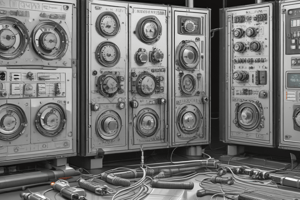Podcast
Questions and Answers
What is the primary function of the sensing element in a transducer?
What is the primary function of the sensing element in a transducer?
- To convert the output into an electrical signal
- To detect physical phenomena such as temperature or pressure (correct)
- To convert electrical signals into other forms of energy
- To amplify the electrical signal
What is the role of the transduction element in a transducer?
What is the role of the transduction element in a transducer?
- To convert the output into an electrical signal (correct)
- To detect physical energy
- To convert electrical signals into other forms of energy
- To amplify the electrical signal
What is the purpose of converting physical energy into an electrical signal in a transducer?
What is the purpose of converting physical energy into an electrical signal in a transducer?
- To amplify the signal
- To generate heat
- To convert electrical signals into other forms of energy
- To enable the signal to be read and processed by electronic components (correct)
What determines the efficiency of a transducer?
What determines the efficiency of a transducer?
What is an example of an input transducer?
What is an example of an input transducer?
What is the purpose of a transducer in a medical ultrasonography device?
What is the purpose of a transducer in a medical ultrasonography device?
What is the primary function of a transducer?
What is the primary function of a transducer?
What is the key difference between a sensor and a transducer?
What is the key difference between a sensor and a transducer?
What is the purpose of the sensing element in a transducer?
What is the purpose of the sensing element in a transducer?
What type of transducer converts mechanical force into an electrical signal?
What type of transducer converts mechanical force into an electrical signal?
What is the result of the conversion process in a sensor?
What is the result of the conversion process in a sensor?
What is the essential function of transduction in electronic devices?
What is the essential function of transduction in electronic devices?
Flashcards are hidden until you start studying
Study Notes
Transducers: Sensors and Transduction Principles
A transducer is an electronic device that converts energy from one form to another, often from physical force to an electrical signal. It is a crucial component in various applications, from medical devices to industrial control systems.
Sensors and Transducers: What's the Difference?
While the terms "sensor" and "transducer" are sometimes used interchangeably, they do have distinct roles. A sensor is a device that detects physical quantities such as temperature, pressure, or sound and converts them into an electrical signal. This conversion process is not always explicit, as in the case of a mercury thermometer, where the mercury expands with temperature, indicating a change in physical conditions.
On the other hand, a transducer is specifically designed to convert a physical force into an electrical signal. This conversion is essential for many electronic devices, as it allows for the measurement and control of various physical parameters. Examples of transducers include piezoelectric sensors, which convert mechanical force into an electrical signal, and ultrasonic transducers, which convert electrical signals into ultrasound energy and vice versa.
Transduction Principles
The process of transduction involves two main components: the sensing element and the transduction element. The sensing element, also known as the sensor, is the part of the transducer that responds to the physical phenomenon. The response of the sensing element depends on the physical phenomenon it is designed to detect, such as temperature, pressure, or sound waves.
The transduction element, also called the secondary transducer, is responsible for converting the output of the sensing element into an electrical signal. This conversion is necessary for the electrical signal to be read and processed by other electronic components. For example, in a piezoelectric sensor, the piezoelectric material changes its size and shape in response to voltage, generating an electrical signal that can be read.
Types of Transducers
Transducers can be categorized into two main types: input transducers and output transducers. An input transducer, or sensor, takes in physical energy and converts it into an electrical signal. A microphone, for instance, converts sound waves into an electrical signal that can be transferred through wires.
An output transducer, or actuator, takes in electrical signals and converts them into other forms of energy. A lamp converts electricity into light, while a motor converts electricity into motion.
Transducer Efficiency
The efficiency of a transducer is calculated as the ratio of the output power in the desired form to the total power input. This ratio is represented mathematically as the ratio of the output power (Q) to the input power (P). Transducer efficiency can vary depending on the specific device and the conversion process, with no transducer being 100% efficient. Some power is always lost during the conversion process, which is manifested as heat.
Applications of Transducers
Transducers have a wide range of applications across various industries. They are used to measure and control physical parameters in engine systems, detect muscle movement, and are integral components in devices such as ultrasound machines, speakers, and antennas. In the healthcare field, transducers are used in medical ultrasonography and non-destructive testing. They can also be used in sound and vibration rental programs and modal and vibration testing systems.
In summary, transducers are a vital component in modern technology, converting physical energy into electrical signals for measurement and control. Understanding the principles of transduction, the role of sensors and transduction elements, and the efficiency and applications of transducers is essential for anyone working in fields that rely on these devices.
Studying That Suits You
Use AI to generate personalized quizzes and flashcards to suit your learning preferences.





